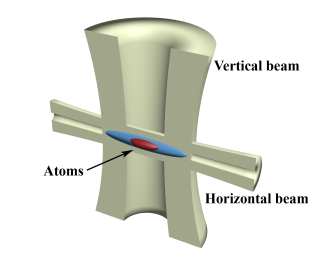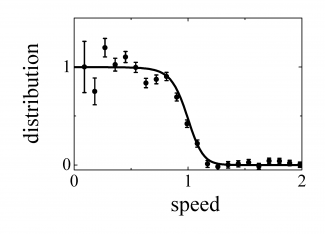Members of the Jin group found a way to measure for the first time the a type of abstract “surface” in a gas of ultracold atoms that had been predicted in 1926 but not previously observed. Jin and her colleagues are leading researchers in the field of ultracold Fermi gases made up of thousands to millions of fermions.
Fermions, including electrons and some types of atoms such as potassium (40K), cannot occupy exactly the same quantum state. This property leads to a unique distribution of the energy, or speed, of a collection of fermions at low temperature. The distribution has a sharp boundary called a Fermi surface (Figure 1). And, under the right conditions, an ultracold gas of fermions should exhibit a sharp step, or boundary, in the distribution of speeds.
Famous physicists Enrico Fermi and Paul Dirac predicted the existence of this step nearly 100 years ago. For most of a century, physicists were unable to directly see the Fermi surface by looking at the speeds of a bunch of fermions. One difficulty was that fermions interact in virtually all systems except for ultracold gases where interactions can be controlled by adjusting the magnetic field.
However, confining ultracold gas clouds in traps (using light or magnetic fields) does cause variations in the density of the gas in different parts of the cloud. These density variations wash out the sharp Fermi surface when speed distributions are averaged over an entire ultracold gas cloud. So, although physicists were sure that a Fermi surface was present in small sections of the clouds of ultracold fermions, they were unable to “see” it experimentally.




 The Physics Frontiers Centers (PFC) program supports university-based centers and institutes where the collective efforts of a larger group of individuals can enable transformational advances in the most promising research areas. The program is designed to foster major breakthroughs at the intellectual frontiers of physics by providing needed resources such as combinations of talents, skills, disciplines, and/or specialized infrastructure, not usually available to individual investigators or small groups, in an environment in which the collective efforts of the larger group can be shown to be seminal to promoting significant progress in the science and the education of students. PFCs also include creative, substantive activities aimed at enhancing education, broadening participation of traditionally underrepresented groups, and outreach to the scientific community and general public.
The Physics Frontiers Centers (PFC) program supports university-based centers and institutes where the collective efforts of a larger group of individuals can enable transformational advances in the most promising research areas. The program is designed to foster major breakthroughs at the intellectual frontiers of physics by providing needed resources such as combinations of talents, skills, disciplines, and/or specialized infrastructure, not usually available to individual investigators or small groups, in an environment in which the collective efforts of the larger group can be shown to be seminal to promoting significant progress in the science and the education of students. PFCs also include creative, substantive activities aimed at enhancing education, broadening participation of traditionally underrepresented groups, and outreach to the scientific community and general public.